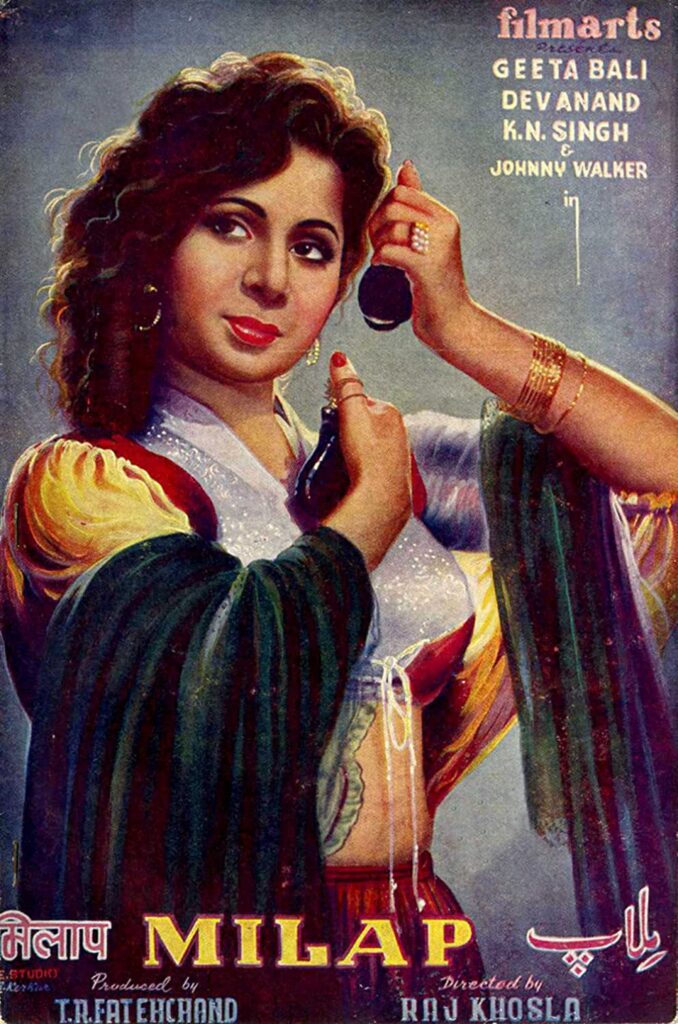Today, Milap is remembered mainly as Raj Khosla’s directorial debut and nothing more. But to be fair to Khosla, a most underrated director, the film does show enough of his cinematic craft to suggest he was destined for better things. Which he subsequently proved with his following film, CID (1956), which led him to having quite a successful career in the Hindi film industry.
A rich man leaves all his wealth to a country bumpkin, Rajinder (Dev Anand), much to the chargin of all his close relatives. Rajinder comes to Bombay to collect his money and finds he has to content with city slickers, moochers, fundraisers and the like, all wanting a share of the pie. The wily lawyer (KN Singh), while pretending to be on Rajinder’s side, wants it all and plants Asha (Geeta Bali) to get close to Rajinder and pretend to be in love with him to get him to part with his wealth. Asha has no choice as he has a hold on her and goes along, only to genuinely fall for Rajinder’s simple, rustic ways…
The film, produced by TR Fatehchand who also produced Guru Dutt’s Jaal (1952), where Khosla was an assistant director, is obviously and almost totally ‘inspired’ from the Frank Capra masterpiece, Mr Deeds Goes to Town (1936). So we have Dev Anand and Geeta Bali doing the Gary Cooper-Jean Arthur act. Only here Geeta Bali isn’t a reporter but a ‘plant’. And, of course, being the heroine, she isn’t naturally bad but is forced to be so, in order to help her criminal brother on the run. To Khosla’s credit, he still keeps the film moving along engrossingly enough. And at least in his country bumkin avtar, he has managed to somewhat shorn Dev Anand off the ‘starry’ mannerisms that Anand was beginning to incorporate into each and every role he played.
In fact, Anand gives a fairly good account of himself in the film and one would have to count this as one of his better performances. Geeta Bali, in a role tailor-made for her, is a natural and all but steals the film with her lively and bubbly performance. KN Singh makes for a great, slimy, sophisticated villain as always but the Johnny Walker comedy act is a big, big weakness in the film. In particular, the tacky endless sequence with Johnny behind the wheel of the car just seems to go on and on and gets on one’s nerves after a while.
Technically, the film is reasonably competent for its time. Apart from VK Murthy’s efficient camerawork, special mention must be made of N Dutta’s musical score, in particular the Geeta Dutt solos – Jaate Ho To Jaao Par Jaaoge Kahan and Humse Bhi Kar Lo Kabhi Kabhi To Meethi Meethi Do Baaten (No one could get the sexy effect quite like her) – and the romantic Lata Mangeshkar solo, Yeh Baharon Ka Sama. In the last named, there are also the early signs of some fine picturization of the songs, which was to become a major strength of Khosla’s. This was something picked up from mentor Guru Dutt, whom Khosla had assisted in Baazi (1951), Jaal, Baaz (1953) and Aar Paar (1954) prior to this film. In fact, the way Khosla introduces Geeta Bali in the Humse Bhi Karlo number in this film, is practically identical to the way Guru Dutt had introduced Shakila in the Babuji Dheere Chalna song from Aar Paar.
All in all, Milap is watchable enough fare that marks a reasonably assured debut for Khosla.
Hindi, Comedy, Drama, Thriller, Black & White


